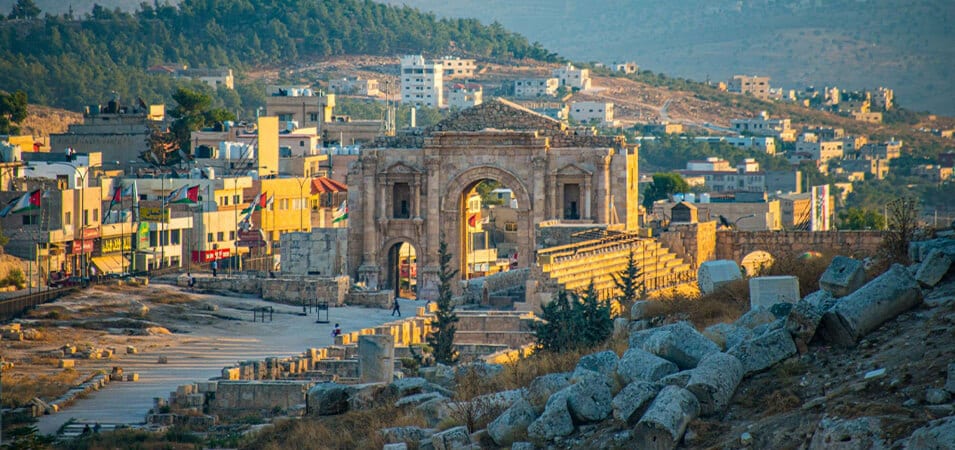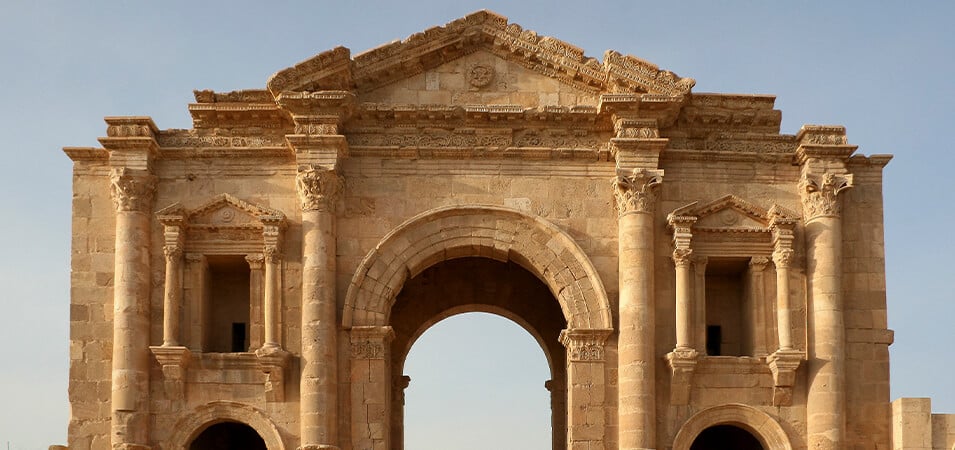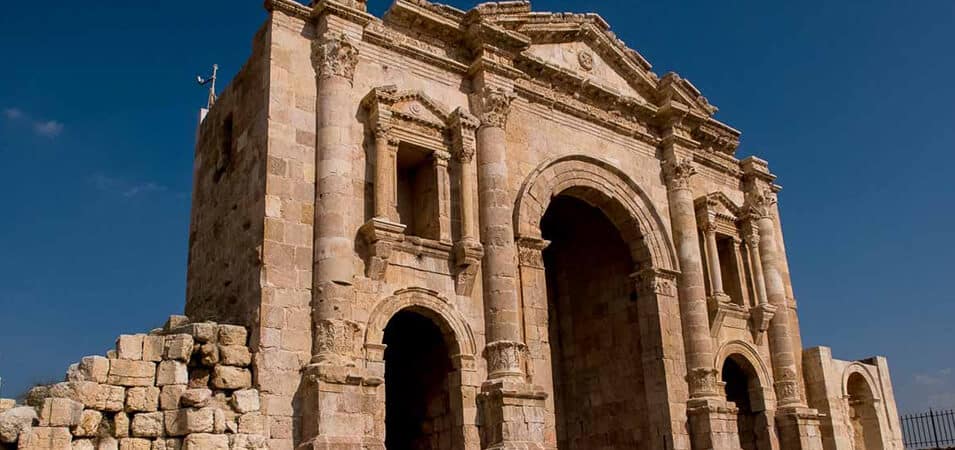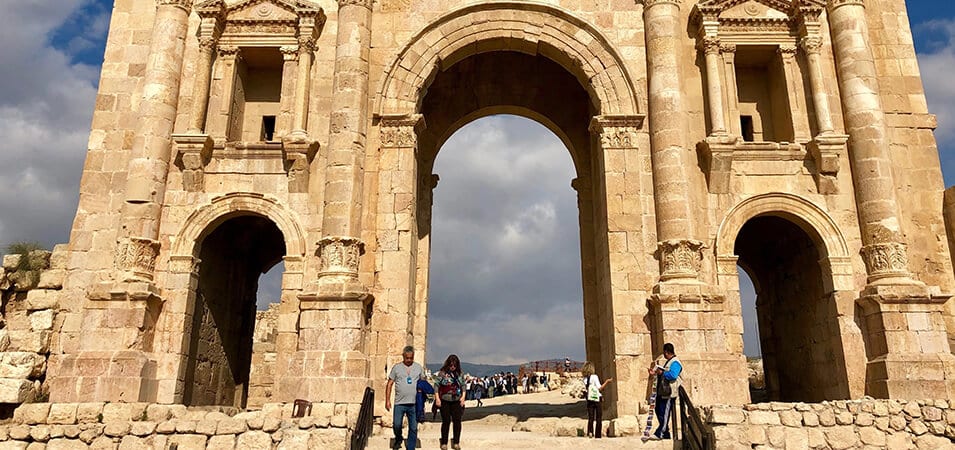The Arch of Hadrian in Jerash is a magnificent architectural marvel that stands as a testament to the grandeur of the Roman Empire. This imposing structure, located in the ancient city of Jerash, Jordan, holds immense historical and cultural significance. As a triumphal arch, it symbolizes power and authority, marking a gateway to the past and transporting visitors to a bygone era of luxury and conquest.
The Arch of Hadrian holds a special place in the history of Jerash, formerly known as Gerasa; constructed during the 2nd century, it reflects the period of Roman rule in the region and the architectural achievements of the time. This iconic landmark showcases the city’s rich heritage. It is a tangible link to the past, reminding us of the city’s strategic importance and connections with the more expansive Roman Empire.
Emperor Hadrian, renowned for his architectural pursuits, was a prominent figure during the Roman Empire’s heyday. His reign from 117 to 138 AD marked a period of stability and cultural flourishing. Hadrian’s interest in architecture and extensive travels influenced the construction of many iconic structures, including the Arch of Hadrian. His visits to various cities across the empire aimed to solidify Roman authority and establish connections with local communities.
The following sections will delve deeper into the historical context, architectural features, and significance of the Arch of Hadrian, exploring its rich tapestry of history and culture.
Don’t Miss checking out our Jordan Travel Packages.
Location of Jerash
Jerash is located in Jordan, a country in the Middle East. Jerash town in northwestern Jordan, 48 km (30 km) north of Amman. It lies in the Jordan Valley near the Jordan River and Israel. Jerash’s well-preserved Roman ruins include the Temple of Artemis, Oval Plaza, and Roman theater. These archaeological sites attract tourists from around the world interested in exploring the region’s rich historical and cultural heritage.
History of the Arch of Hadrian in Jerash
During the 2nd century, Jerash, known as Gerasa in ancient times, was under Roman rule. The Roman presence in the region led to the construction of various architectural marvels, including the Arch of Hadrian. Erected as a triumphal monument, the arch commemorates significant military victories and symbolizes Roman authority and power.
Jerash peaked with magnificent structures like the Oval Plaza and Hadrian’s Arch. With the decline of the Roman Empire, the city transitioned to a Christian center and witnessed Byzantine development. In the 7th century, Jerash was captured by Muslims during the Islamic conquests. Over time, the city declined due to earthquakes, changing trade routes, and conflicts.
Archaeologists rediscovered it in the 19th century, and extensive excavations revealed remarkably preserved ruins. Today, Jerash stands as one of the best-preserved Roman cities outside of Italy, showcasing its rich history and attracting visitors from around the globe.
Architectural of Jerash Jordan
The architectural landscape of Jerash, Jordan, is a captivating blend of ancient grandeur and cultural heritage. This historical city is renowned for its well-preserved Roman ruins, providing a window into the past and offering a glimpse into the architectural achievements of the time.
The structures in Jerash showcase a harmonious fusion of Roman and Byzantine architectural styles. Every corner of Jerash exudes architectural magnificence, from the towering columns of the Temple of Artemis to the intricately carved facades of the Oval Plaza.
The colonnaded streets, adorned with Corinthian columns, lead visitors through the city’s ancient heart, while the Arch of Hadrian stands as a symbol of triumph and power. The Greco-Roman theaters, with their tiered seating and impressive acoustics, transport spectators back to the days of ancient entertainment.
The architectural landscape of Jerash is a testament to the city’s historical significance and role as a thriving hub of civilization. It is a living testament to the architectural genius of the ancient world, leaving visitors in awe of the skill and vision of those who came before us. A visit to Jerash is a journey through time, where the echoes of the past resonate through its magnificent structures, captivating the imagination of all who wander its ancient streets.
Comparison Arch with Other Triumphal Arches
The Arch of Hadrian in Jerash, Jordan, holds a unique place among other triumphal arches of the Roman Empire. A comparison with these architectural marvels provides valuable insights into their distinct features and historical significance.
Unlike to Roman triumphal arches like the Arch of Constantine, the Arch of Hadrian has a distinct architectural style. The composite Arch of Constantine shows the late Roman Empire’s grandeur, whereas the Arch of Hadrian is more classical.
The Arch of Hadrian’s design exhibits a strong influence from both Roman and Greek architecture. Corinthian columns and exquisite carvings honor ancient Greek art, but the building retains the triumphal arch shape of Roman triumphalism.
Additionally, the Arch of Hadrian stands out for its location and purpose. The city of Jerash in the eastern Roman Empire symbolized Roman might and control. Unlike the Arch of Titus at Rome, several other triumphal arches were built to honor emperors and military successes.
While the Arch of Hadrian is smaller than some of the more famous triumphal arches, it is no less significant historically and culturally. Its distinctive architectural influences and position as a symbol of Roman power make it an intriguing topic for comparison with other triumphal arches around the empire. Through such comparisons, we can deepen our understanding of the diverse architectural achievements and political undertones of the Roman Empire.
Importance of Jerash as a crossroads between the Mediterranean and the Arabian Peninsula
Jerash, located in modern-day Jordan, was an ancient crossroads between the Mediterranean and the Arabian Peninsula. Situated on the historic trade routes, this city was crucial in facilitating cultural, economic, and political exchanges between these regions.
As a key trading hub, Jerash thrived due to its strategic location. Merchants and caravans passing through Jerash brought goods, ideas, and technologies from the Mediterranean to the Arabian Peninsula and vice versa. The city became a melting pot of diverse cultures, fostering the exchange of languages, religions, and customs.
The trading hub of Jerash is crucial to the economy. Its position allowed for exchanging commodities such as textiles, spices, precious metals, and agricultural products, enriching the local economy and attracting merchants from far and wide.
Furthermore, Jerash’s status as a crossroads brought political influence and power to the region. Rulers and conquerors sought to control this strategic city, recognizing its potential to dominate trade routes and establish political alliances.
Overall, Jerash’s position as a crossroads between the Mediterranean and the Arabian Peninsula in ancient times was of paramount importance. It served as a vital conduit for exchanging goods, ideas, and power, shaping the history and development of the surrounding regions.
Don’t Miss to Check out our Related Article :




